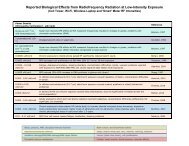Evidence for Effects on Neurology and Behavior - BioInitiative Report
Evidence for Effects on Neurology and Behavior - BioInitiative Report
Evidence for Effects on Neurology and Behavior - BioInitiative Report
Create successful ePaper yourself
Turn your PDF publications into a flip-book with our unique Google optimized e-Paper software.
the central nervous system are bathed in the cerebrospinal fluid (CSF) that fills the ventricles of<br />
the brain <strong>and</strong> the space at the core of the spinal cord.<br />
The brain is generally subdivided into regi<strong>on</strong>s (areas) based <strong>on</strong> embryological origins. The<br />
anterior porti<strong>on</strong> of the neural tube, the embry<strong>on</strong>ic tissue from which the nervous system is<br />
developed, has three regi<strong>on</strong>s of expansi<strong>on</strong>: the <str<strong>on</strong>g>for</str<strong>on</strong>g>ebrain, midbrain, <strong>and</strong> hindbrain. From the<br />
<str<strong>on</strong>g>for</str<strong>on</strong>g>ebrain, the cerebral hemispheres <strong>and</strong> the diencephal<strong>on</strong> will develop. The diencephal<strong>on</strong><br />
c<strong>on</strong>sists of the thalamus, epithalamus, subthalamus, <strong>and</strong> hypothalamus. The midbrain remains<br />
mostly unchanged from the original structure of the neural tube; however, two pairs of structures,<br />
the superior <strong>and</strong> inferior colliculi, develop <strong>on</strong> its dorsal surface. These are parts of the visual <strong>and</strong><br />
auditory systems, respectively. The hindbrain develops into the medulla, p<strong>on</strong>s, <strong>and</strong> cerebellum.<br />
The thalamus of the diencephal<strong>on</strong> is divided into various groups of cells (nuclei). Some of<br />
these nuclei are relays c<strong>on</strong>veying sensory in<str<strong>on</strong>g>for</str<strong>on</strong>g>mati<strong>on</strong> from the envir<strong>on</strong>ment to specific regi<strong>on</strong>s<br />
of the cerebral cortex, such as the lateral <strong>and</strong> medial geniculate nuclei that relay visual <strong>and</strong><br />
auditory in<str<strong>on</strong>g>for</str<strong>on</strong>g>mati<strong>on</strong>, respectively, from the eyes <strong>and</strong> ears to the cerebral cortex. Other nuclei<br />
have more diffuse innervati<strong>on</strong>s to the cerebral cortex. The hypothalamus is involved in many<br />
physiological regulatory functi<strong>on</strong>s such as thermoregulati<strong>on</strong> <strong>and</strong> c<strong>on</strong>trol of secreti<strong>on</strong> of<br />
horm<strong>on</strong>es.<br />
The cerebral hemispheres c<strong>on</strong>sist of the limbic system (including the olfactory bulbs, septal<br />
nucleus, amygdala, <strong>and</strong> hippocampus), the basal ganglia (striatum), <strong>and</strong> the cerebral cortex. The<br />
limbic system serves many behavioral functi<strong>on</strong>s such as emoti<strong>on</strong> <strong>and</strong> memory. The striatum is<br />
primarily involved in motor c<strong>on</strong>trols <strong>and</strong> coordinati<strong>on</strong>. The cerebral cortex especially in the<br />
higher animal species is divided into regi<strong>on</strong>s by major sulci: fr<strong>on</strong>tal, parietal, temporal, <strong>and</strong><br />
occipital cortex, etc. The functi<strong>on</strong> of some regi<strong>on</strong>s can be traced to the projecti<strong>on</strong> they receive<br />
from the thalamus, e.g., the occipital cortex (visual cortex) processes visual in<str<strong>on</strong>g>for</str<strong>on</strong>g>mati<strong>on</strong> it<br />
receives from the lateral geniculate nucleus of the thalamus <strong>and</strong> the temporal cortex (auditory<br />
cortex) receives auditory in<str<strong>on</strong>g>for</str<strong>on</strong>g>mati<strong>on</strong> from the medial geniculate nucleus. There are other<br />
cortical areas, however, known as sec<strong>on</strong>dary sensory areas <strong>and</strong> 'associati<strong>on</strong>' cortex that receive<br />
no specific thalamic innervati<strong>on</strong>s. One example of the associati<strong>on</strong> cortical areas is the prefr<strong>on</strong>tal<br />
cortex, which is supposed to subserve higher behavioral functi<strong>on</strong>s, e.g., cogniti<strong>on</strong>.<br />
The basic design of the central nervous system is similar am<strong>on</strong>g species in the phylogenetic<br />
scale; however, there are differences in the details of structure am<strong>on</strong>g species. Most of the brain<br />
regi<strong>on</strong>s menti<strong>on</strong>ed in the above secti<strong>on</strong>s have been studied in bioelectromagnetics research to a<br />
various extent.<br />
On the neurochemical level, neur<strong>on</strong>s with similar biochemical characteristics are usually<br />
grouped together to <str<strong>on</strong>g>for</str<strong>on</strong>g>m a nucleus or gangli<strong>on</strong>. In<str<strong>on</strong>g>for</str<strong>on</strong>g>mati<strong>on</strong> is transmitted by electrochemical<br />
means via fibers (ax<strong>on</strong>s) protruding from the neur<strong>on</strong>. In additi<strong>on</strong> to making local innervati<strong>on</strong>s to<br />
other neur<strong>on</strong>s within the nucleus, nerve fibers from the neur<strong>on</strong>s in a nucleus are also grouped<br />
into bundles (pathways) that c<strong>on</strong>nect <strong>on</strong>e part of the brain to another. In<str<strong>on</strong>g>for</str<strong>on</strong>g>mati<strong>on</strong> is generally<br />
passed from <strong>on</strong>e neur<strong>on</strong> to another via the release of chemicals. These chemicals are called<br />
neurotransmitters or neuromodulators depending up<strong>on</strong> their functi<strong>on</strong>s. Many neurotransmitters<br />
have been identified in the central nervous system. Some are small molecules such as acetylcholine,<br />
norepinephrine, dopamine, serot<strong>on</strong>in, <strong>and</strong> amino-butyric acid (GABA), whereas the<br />
others are polypeptides <strong>and</strong> proteins such as the endogenous opioids, substance-P, etc. <str<strong>on</strong>g>Effects</str<strong>on</strong>g> of<br />
RFR <strong>on</strong> most of these neurotransmitters have been investigated. Nerve fibers in a pathway<br />
usually release the same neurotransmitter. The anatomy of some of these neurotransmitter<br />
23



